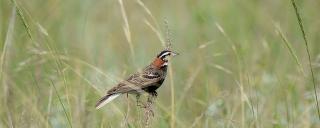
Grassland Nesting Bird Habitat
General Information
Grassland nesting birds include songbirds (e.g., Baird’s sparrow), upland nesting shorebirds (e.g., long-billed curlew), raptors (e.g., northern harrier), and even some waterbirds (e.g., American bittern). Numerous nongame species, or those not typically hunted, use grasslands during some part of their life cycle. These birds are often disregarded as "sparrows" or considered insignificant. Nongame species are an integral component of nature. Loss of a seemingly insignificant species can cause other animals to decline or vanish. Even so, animals that live in North Dakota are part of the state’s legacy, and concern for the conservation of these birds is growing. Twelve grassland birds are considered endemic (or those that evolved specifically within grassland) to the Great Plains, and eight are found in North Dakota. Species such as chestnut-collared longspur, marbled godwit, and Sprague’s pipit evolved with large grazing animals (i.e., bison) and adapted to the open prairie. The principal factor negatively affecting grassland bird populations is the loss of native prairie. Nongame species from grasshopper sparrows to burrowing owls have benefited from conservation efforts for waterfowl and other game species. Most conservation practices benefiting game species also benefit nongame. There are, however, a few practices which may be detrimental to grassland birds, such as planting trees in, or near, native prairie.
General Habitat Requirements
Grassland nesting birds use a variety of grasslands, from tall to short, thin to dense and heavily grazed to idle. For example, some species use only grassland less than about 18 inches tall and others use only grassland more than 48 inches tall. Wilson’s phalarope, a grassland nesting shorebird, can be found nesting just feet away from blue-winged teal in shorter, less dense grass. Bobolinks, a striking black sparrow-like bird with a white back, will use tall, dense grassland that ring-necked pheasants prefer. Essentially, grassland nesting birds need open grasslands with few trees. They forage on forbs, grass seeds and a variety of insects found in grassland near crop fields. A complex of wetlands in the grassland can also be beneficial.
Management Considerations
- Maintain large, contiguous areas of grassland, particularly native prairie.
- Provide a variety of grassland heights (i.e., tall grass over 48 inches to short grass of about 18 inches).
- Maintain grasslands free of or with little woody vegetation.
- Burn, mow or graze on a rotational schedule (i.e., manipulate sections of a grassland, not the entire area at once).
- When cutting hay or mowing, leave the highest possible height (12-24 inches).
- Preserve and maintain grassland/forb communities in large (over 40 acres) contiguous tracts by prescribed rotational burning and rotational mowing when and where appropriate.
- Preserve native prairie. It is not recommended to convert native prairie for wildlife food plots, introduced grass species, trees, etc.
- Use a stripper header, and delay cutting until after primary nesting season (April 15 through August 1).
- Plant a diverse mixture of native grasses and forbs on cropland.
- Restore hydrology and vegetation to degraded wetlands.
- Utilize no-till and minimum-till practices on cropland.
- Control tall woody vegetation, including single trees that act as raptor perches and raptor nest sites.
- Use flushing bars, avoid night mowing, and cut hay fields from the center outward or toward undisturbed habitat.
